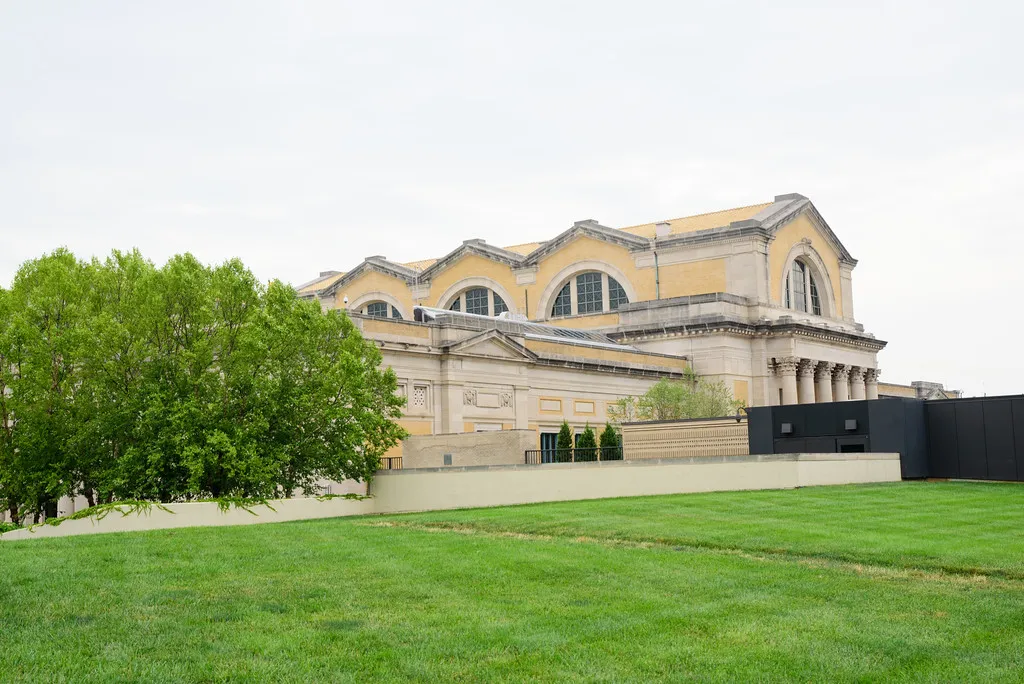In addition to the Missouri Botanical Gardens to see Chihuly and going to the Gateway Arch we also went to the Saint Louis Art Museum or SLAM.

It is a gorgeous museum located in Forest Park which I loved as it was surrounded in GREEN.
 |  | |
|---|---|---|
 |  |
Sara and I got to the museum before it opened and walked around the sculpture park. I am a big fan of sculpture and was so happy to see works by some of my favorites, Moore, Renoir and Paine and new pieces by Oldenburg, Nagare, Maillol, Gasteiger and Lipchitz.
Oldenburg
The first piece we saw is this piece called Giant Three-Way Plug and we had to get a closer look and picture.
 Claes Oldenburg
Giant Three-Way Plug, 1970-71
Claes Oldenburg
Giant Three-Way Plug, 1970-71
According to the plaque:
Claes Oldenburg produced monumental sculptures of everyday consumer objects. The artist described it as resembling "an implement left over from war, returning to nature" Oldenburg first installed the sculpture here in 1971.
It is made of Cor-Ten Steel and Bronze. Claes was born in 1929 in Sweden and died in 2022 in the United States.
Henry Moore
I am a very big fan of Henry Moore, on of my first exhibits in a botanical garden was Henry Moore in the New York Botanical Gardens in 2008. The SLAM has three Moore sculptures.
This piece is called Standing Figure and it was made in 1950. Usually I can recognize a Henry Moore piece and I had not idea this was done by him. It looks like a little alien and it fascinated me!
 |  |  |
|---|
Henry Moore is a English artist that lived from 1898-1986. He was a radical artist in his time who created monumental semi abstract art. He is my gateway to modern and abstract art.
 |  | |
|---|---|---|
| Two-Piece Reclining Figure No.2 , 1959-60 | Two-Piece Reclining Figure No.1 , 1959-60 |
Masayuki Nagare
 Confluence, 1964-65
Confluence, 1964-65
According to the plaque:
Masayuki Nagare sculpture an arching curve of granite, counterbalancing the rough and polished surfaces of the stone. The Japanese artist visited St. Louis in 1964, and this work, inspired by the confluence of the Missouri and Mississippi rivers, suggests the changing swell of the water and waves. His art is grounded in a deep attachment to nature and a respect for the intrinsic qualities of the stone.

Venus Victorious
Venus Victorious is a sculpture by the famous French impressionist painter August Renoir and his assistant the young Spanish Sculptor Richard Guino. It was completed in 1916 three years before Renoir died.
 |  |
|---|
The Mountain
This beautiful statue of a female nude is called The Mountain. It is created by Aristide Maillol a French artist who lived from 1861- 1944. This sculpture is made of lead. I really enjoy taking portrait picture of sculptures.


Hercules and the Hydra
The most impressive sculpture to me is this bronze piece by the German artist Mathias Gasteiger. It was created from 1921-1930 and is of the Greek hero Hercules battling Hydra the many headed snake. It reminds me of another of my favorite sculptures- Lacoon.

 |  |
|---|
Look at those muscles made in bronze!

The Bather
Here we have a cubist sculpture by Jacques Lipchitz who is a Lithuanian born French artist that lived from 1891-1973.
The cubist movement was from 1907-1918 and this piece was created shortly after in 1923-25.
According the plaque:
This monumental bather was Lipchitz's first life-sized work and the culmination of his experiment with Cubist visual language.
I don't know enough about cubism to understand it very well and therefore the works are hard to understand also.

Placebo
I was introduced to Roxy Paine in the National Gallery of art sculpture garden. This tree is very similar. They are both made of stainless steel and stand the height of a tree.
According the plaque:
Roxy Paine explained, "I take this organic majestic being and break it down into components and rules."
It is made by welding together standard industrial piping. Placebo highlights the complex relationship between the man-made and the natural world.
 |  |
|---|

Here are a few more shots of the entrance to the museum.

 |  |
|---|
Next time we will go in and see the great work inside!
Sources:
Henry Moore
Cubism
The plaques next to the sculptures.

*Art Talk Series Highlights
Art Talk: 2022 Posts
Art Talk: 2021 Posts
Art Talk: 2020 Posts
Art Talk: 2019 Posts
Art Talk: 2018 Posts
